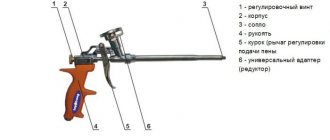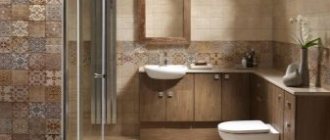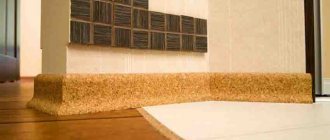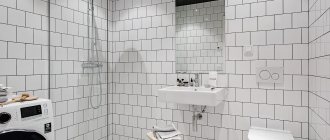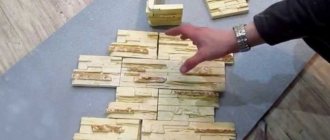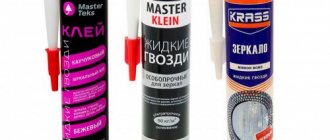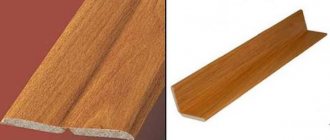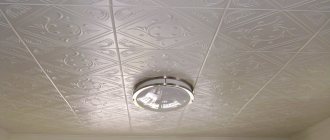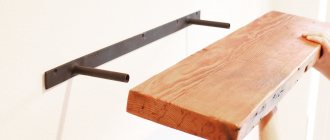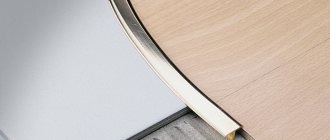Glue tiles using liquid nails - when to do it
Laying tiles in the bathroom is usually done using special building mixtures or cement. But in most cases, gluing tiles using liquid nails will be the right decision, because it is a special composition that has a high level of adhesion, is durable and reliable.
When choosing tile adhesive, experts often give preference specifically to liquid nails, because when using cement, a large amount of dust cannot be avoided, and it will take a very, very long time to clean the bathroom.
working with cement is labor-intensive - the solution must be mixed in small portions, which is very difficult to do manually, and it is impossible to bring a concrete mixer into the house. In such a situation, liquid nails will be an excellent solution - with their help, the process of gluing tiles will be greatly simplified.
What are liquid nails
Working with cement is sometimes labor-intensive: you need to mix the solution and not always in small portions, during the work a large amount of dust is generated, and cleaning takes a lot of time.
Sometimes you even have to resort to specialized construction equipment (concrete mixers).
The solution in this situation may be to use liquid nails. Their use simplifies working with tiles.
“Liquid nails are a polymer-based adhesive solution with the addition of chalk, white clay, and fillers for leveling porous surfaces of bases.
It is placed in a special tube, which is convenient for use in construction guns.” Since the liquid composition is universal, it can be used to glue completely different textures. Such as ceramics, glass, natural and artificial stone.
When hardened, it forms a strong connection that does not lose its properties for a long time. The color range can be varied, but the following shades can be found on wide sale:
- white;
- grey;
- brown;
- transparent and translucent;
- yellow;
- black.
It is preferable to use white nails for work, and use a transparent liquid nail composition to seal plumbing products, since its strength is reduced.
Installation of plastic panels in the bathroom
Plastic panels in the bathroom have become a reality thanks to new technologies. Their fastening has been greatly simplified with the use of liquid nails.
How to glue plastic panels in the bathroom:
- Pre-prepare the walls;
- Bring the opened packaging of the panels into the room to adapt to temperature and humidity;
- Using a tape measure and a felt-tip pen, take the necessary measurements and markings of the wall and plastic panels;
- Apply the adhesive solution to the back surface of the panels with dotted lines - the distance between the lines is 10 cm;
- Attach the plastic panel tightly to the wall;
- Lubricate the grooves of the panels with sealant;
- Complete drying in 24-48 hours.
Plastic panels for the bathroom
Liquid nails have many advantages compared to other adhesives. Their use will facilitate renovation work in the bathroom and other rooms. Gypsum stone, ceramic and ceiling tiles, plastic and MDF panels, glued with liquid nails, will remain on the surfaces for a long time.
Technology of insulating external walls with mineral wool with a ventilated facade What does the density indicator in kg per m³ say about mineral wool? How to remove silicone sealant from tiles, effective means, methods
The article is useful, it’s a pity that I read it after installing my own closet in the bedroom. Of course, it turned out easier for us...
After the renovation, there were traces of silicone left here and there, apparently the builders weren’t very careful, and I couldn’t wipe them off...
Wonderful article! The material on the use of mineral wool is extensively and clearly presented, which makes it possible not to search on the Internet...
Before starting work on removing sealant, you need to understand what type it is. Based on this, tools and chemicals are selected...
Catalog of regulatory documents The most popular GOSTs and building codes
Have questions? Ask an expert
A short description of the section with questions and answers. On the list of sentences for example
Types of glue
Depending on the properties and liquid composition of nails, the following types of adhesives can be found on sale:
- Acrylic. They are based on acrylic in the form of a water emulsion. They are safe, non-toxic and completely odorless. Can be used indoors without harm to humans.
- Neoprene. This type, on the contrary, is unsafe for health, since it is based on polymer components and organic solvents. When using them, do not forget about protective equipment and ventilate the room very carefully. However, their adhesion, compared to acrylic ones, is higher. They are better suited for gluing tiles and other glossy and smooth materials because they do not lose their properties due to changes in temperature and humidity.
Varieties
This type of glue is not the best way to attach the covering to the floor. The cost of the work will be very considerable due to the high cost of the adhesive solution. However, if we consider liquid nails as a method of fastening tiles, then we may also encounter the problem of choice. For many, there is only one type of them under the general name “liquid nails”, without any differences. However, there are at least two types of such mixtures:
- Neoprene, based on organic solvents.
- Acrylic, created on the basis of a water emulsion.
Both types do their job well, but have different properties that affect where they can be used. They will be the decisive factor when choosing the appropriate option. Acrylic water-based solutions contain a minimum of harmful substances and are practically harmless. Neoprene ones are based on organic solvents, which, theoretically, can be harmful to health.
It would seem that the choice is obvious, but not everything is so simple. Acrylic liquid nails perfectly attach the coating to rough and porous surfaces and are almost as strong as neoprene nails; however, when exposed to moisture, the acrylic base disintegrates and the fixation weakens. A sudden change in temperature also has a negative effect on the mixture. Therefore, it can only be used in dry rooms with a constant temperature.
Neoprene adhesives perfectly withstand all these impacts and retain their properties under any conditions. In addition, they dry faster, create a stronger connection, and also resist the formation of fungi, mold and various harmful bacteria. This is ideal for use in damp areas. It has one significant drawback: during drying and working with such a solution, harmful substances are released and it is necessary to protect yourself from fumes.
Advantages and disadvantages
The popularity of these types of nails is due to the ability to use them not only for work in the bathroom, but also in the kitchen. Let us note a number of advantages:
- Water resistance. The polymers included in the “nails” are moisture resistant. The joining seam is not subject to deformation even in direct contact with water.
- Strength. When dry, a durable layer is formed that connects the tile material and the base.
- Immutability of properties. Cement and gypsum mixtures lose their bonding properties over time. Nails have these properties unchanged.
- High adhesion. The ability to withstand weights of up to 80 kg/m2 or more makes it possible to attach large tiles and porcelain stoneware to walls.
- Resistance to negative influences. Not subject to rotting, destruction and mold. Unlike metal nails, they do not corrode.
- Ease of use. Use a nail gun to apply nails. This will facilitate, speed up the process and make the application quite accurate.
- Convenience. Since the nails are completely ready for use, they do not need to be prepared in special ways: dilute them, maintain proportions, or use a special container.
- Purity. The workspace remains clean and dry compared to cement and gypsum mixtures.
Despite the large number of advantages, we note some minor disadvantages. So, due to the rapid fastening, there is practically no time to adjust the connection. The glue sets within 5-10 minutes, so installation should be done quickly and evenly.
And to correct large masonry flaws, experience will be required. “The cost of glue is significantly higher compared to cement mixtures.
It should be noted that if you use only these nails to renovate the entire bathroom, the costs will be significant.
Since “nails” in the liquid version are sold in volumes of only 300-500 milliliters, you will have to overpay for packaging.”
Rules to follow
Despite the fact that it would seem that there may be threats during ordinary tile laying, they still exist.
Learn the basic rules to follow:
- Protecting the skin of your hands and face – neoprene substances contain many chemical elements. When dry mixtures are mixed with water, alkali is formed. In case of contact with human skin, there is a risk of burns.
- Use a respirator - dust emanating from neoprene mixtures can enter the respiratory tract, which can also cause permanent harm to a person.
- Wear glasses - if dust and grains of chemical elements get on the mucous membranes of your eyes, they can cause burns.
If dust does get in somewhere, follow these instructions:
- Rinse the area where the pollen has landed. If you begin to develop deep injuries, seek medical help immediately.
If you swallow dust, you should immediately leave the room for fresh air and try to cough. Be sure to rinse your nose.
If you start to feel unwell or experience pain in your lungs, immediately call an ambulance and seek help from specialists.
Is it possible to glue tiles with liquid nails?
Due to their versatility, liquid nails are widely used in construction and finishing works.
They interact well with porous and smooth materials. With the help of them, ceramic elements can be used to decorate not only walls, but also to cover the floor.
Fine filler fills well the cavities between loosely fitting parts of both large and small weights.
As noted earlier, nails are expensive for finishing entire bathrooms and toilets, but they can be used for some renovation work.
It is not recommended to use glue on areas immersed in water. For these purposes, specialized cement compositions with enhanced water resistance are better suited.
As an option, you can use liquid nails, but be sure to treat the joints with a special moisture-repellent grout.
Glue selection
Adhesive for finishing a bathroom must withstand high humidity. Pay attention to the size of the tiles being connected. Porcelain tiles and large finishing elements should be mounted on nails with increased adhesion.
It is better to fasten elements that are glued to brick or concrete with a neoprene compound, and for drywall use acrylic.
When making a purchase, pay attention to the following characteristics:
- speed of drying;
- suitability for internal and external work;
- temperature regime;
- fire safety;
- smell.
How to properly glue tiles to a wall using liquid nails
You can apply liquid nail composition to walls and floors in different ways:
- directly on the wall;
- on the surface of the tile;
- treat both surfaces at the same time.
The latter option is more often used if the tiles are large or heavy. Before you start gluing, decide on the gluing pattern and arrange the rows so that as few elements as possible are used for connection.
What is an MDF kitchen apron?
MDF wall panels as an apron or wall decoration in the kitchen are an inexpensive, practical and beautiful option. In terms of durability, it is, of course, inferior to tempered glass, ceramic tiles and mosaics, but wins in price, simplicity and speed of installation. MDF is a medium density fiberboard.
Interesting materials:
What to do if the bank does not respond to restructuring? What to do if the slider comes off? What should I do if the pancakes break when turned over? What to do if the dish turns out to be spicy? What to do if the bolt on the wheel does not come off? What to do if the potato tops are tall? What to do if the potato tops are frozen? What to do if the bouquet begins to fade? What to do if the bookmaker doesn’t give you money? What to do if paper wallpaper bubbles?
Preparing the surface for work
First, prepare the base - remove grease, dust, dirt, and other remnants of previous materials. Fill all uneven areas with cement mixture. For the floor, use a cement screed. Otherwise, the ceramic tiles will lie unevenly.
Next, prime the base at least 1-2 times to improve adhesion and wait until the surface is completely dry.
Gluing tiles
When working with neoprene compound, take precautions: use a respirator and gloves.
Place the bottle of liquid nails in a special construction gun, carefully cut off the tip and make a test squeeze onto the surface. Next, perform the following steps step by step:
- apply nails to the surface in a zigzag, dotted pattern or make a grid;
- wait 20-30 seconds;
- lean the tile from bottom to top;
- fix for a few minutes (according to the instructions);
- tap large tiles lightly with a rubber hammer to ensure even fixation;
- After installation is complete, allow the glue to dry completely and set properly (about a week), and only then grind the seams.
Use spacer crosses to maintain equal spacing between tiles. Three hours after completion of work, they can be removed.
Consumption of liquid nails
The consumption of adhesive composition is influenced by factors such as:
- degree of surface uniformity;
- weight and material of the tiles, amount of composition distributed;
- experience and skill of a tiler.
For example, a standard cartridge produces a strip 30-35 meters long with a nozzle-nozzle thickness of approximately 2 millimeters. However, this width will not provide a proper connection. The optimal strip thickness should be 5-6 millimeters.
This is achieved by correctly cutting the tip of the balloon. In this case, there may be enough nails for 10-15 linear meters of tiles of any size.
How much does it cost to install a backsplash in the kitchen?
Prices
| Type of work | Unit measurements | Price |
| Laying a tile backsplash (standard ceramics) | m2 | 950 rub. |
| Laying a tile backsplash (non-standard ceramics) | m2 | 1050 rub. |
| Laying mosaics on an apron without selecting a pattern | m2 | 1500 rub. |
| Grouting joints | m2 | 70 rub. |
Interesting materials:
How to turn off the pedometer on your phone? How to disable tags on your phone? How to turn off traffic on your phone? How to disable USB storage on Fly phone? How to turn off browser notifications on your phone? How to turn off Google Chrome notifications on your phone? How to disable the webcam in Skype on your phone? How to disable internal memory on your phone? How to turn off all notifications on your phone? How to turn off all notifications on your phone?
How to remove liquid nails
Liquid nails are quite firmly fixed to surfaces and can be very difficult to remove. But there are some tools to remove them:
- Solvents and cleaners. They are easy to find in specialized stores. They dissolve the applied layer and completely remove it after 15 minutes.
- Scraper. Using this tool (metal or plastic), dried glue can be removed by scraping it from the surface. A metal spatula will also work.
- Screwdriver. Using the brush attachment, residue can be easily removed from tiles and walls.
- Burner. You need to slightly warm up the previously applied layer to about 60 C and remove the residue using a spatula and a rag. A regular hair dryer can serve as a substitute for a burner.
Laying
Cladding methods
If there is no need to do something unusual, it is better to choose horizontal installation. Tiles with right angles are laid horizontally on the floor using meter and 30 cm levels. If the design allows for the use of tiles and borders of different colors, transitional colors and tiles with patterns, all this will decorate any bathroom.
The vertical method is often used; laying rectangular tiles is suitable for this. If the room has a low ceiling, then this method will create the impression of an increase in the ceiling. Here, too, there is the opportunity to experiment with the use of different colors and shades. With the combined method, vertical and horizontal installation methods are combined. Both versions of tiles with right angles are used.
Checkerboard version of square tiles in contrasting colors. There are also fans of diagonal and other intricate plots.
Stages
- Both surfaces of the tiles must be dry, cleaned and degreased.
- Apply liquid nails to the tile using a snake. On lightweight tiles, glue can be applied in dots.
- Press the tile firmly against the wall and let it sit for a while.
- Liquid nails require up to 24 hours to pre-harden and about a week to fully harden.
- Grout the joints in a week.
- Do not use liquid nails for floor tiles.
See the video below for more details.
How to remove excess glue?
After hardening, liquid nails become very durable; removing excess glue will require a lot of effort, which is why they have such a name.
If you are unable to remove these excesses immediately, then try several removal methods:
Remove excess with a soft, clean cloth. But this must be done before the composition has hardened, when the liquid nails have dried, it is removed with cleaners (based on solvents that are included in the glue). You need to apply the cleaner to the hardened areas of the glue, give it time to soften, rinse and wipe these areas with a clean cloth.
Another option is to use a scraper, but this will take a lot of effort and time. You should not use abrasive materials, as scratches may remain that will ruin the entire look; it is better to use a heat source to heat up the glue; heat using a hair dryer.
When the excess heats up to 60 degrees, it softens and can be easily removed with a spatula.
Remember to take precautions - there should be no flammable substances (paint, solvents) nearby.
Use a trowel (scrape off any drips). Traces of glue can be dissolved with acetone. If you get it on your hands, remove the glue with a tampon using the pinch method after smearing it with Vaseline. Wash your hands thoroughly with warm water and laundry soap.
How long will it last?
If the glue is chosen correctly and all stages of working with tiles are followed, you can be sure that the results of your work will delight all family members for many years. To make the glue last longer, follow these rules:
In case of accidental mistakes, do not allow the glue to harden, correct the situation quickly
Maintain normal temperature conditions in the room where the tiles are laid. In this case, the connection of surfaces is more reliable and durable.
When storing the glue, do not allow it to overheat; it may dry out right in the can.
Service life: how to extend
Due to their properties, the service life of liquid nails can be quite long. Let's give some more tips on using this fastening material:
- adjust the size, thickness and other parameters of the seams immediately after the work until the glue sets;
- do not allow the room temperature to drop to +10 C or lower, which may cause the properties of the adhesive to deteriorate;
- Monitor expiration dates and storage conditions, do not let them dry out.
Liquid nails for partial repairs
If your bathroom needs to replace some loose or damaged tiles, there is no better option than applying liquid nails. First, the surface is cleaned of old glue and degreased, removing all contaminants.
Remove mold and treat the wall with an antifungal compound. Remove the plaster and level the surface. “Leveling surfaces is an important stage of repair work, since without this, the tile material will either sag or become convex relative to another surface.
Liquid nails are applied in the usual way. The parts to be joined are fixed to each other, held for a couple of minutes, after which they are allowed to dry completely.”
How to choose
Before choosing liquid tile adhesive, you need to determine the work to be done:
- Features of fixing tiles with glue - vertically or horizontally.
- The place for finishing is indoors or outdoors.
- The optimal period for liquid nails to harden.
Also, basic facts and information about some adhesive compositions will help you quickly decide on the variety:
- Water-based liquid nails are perfect for installing ceramic tiles.
- When fixing tiles in the bathroom, it is better to choose those types of liquid nails that are moisture-resistant and water-resistant.
- Liquid nails from the Heavy Duty brand are suitable for gluing heavy boards.
- If the base is a brick or concrete wall, then we glue ceramic tiles onto it using liquid nails on an organic basis.
Manufacturers and cost
The cost of packaging such a product depends on the brand and country of manufacture and can vary significantly. On average, the price can vary from 80 to 450 rubles. But you can also find more expensive ones.
Let's take a look at the popular fastening products on the market:
- Titebond Multi Purpose. Firmly holds various materials. The hardening period is approximately 20-30 minutes, which makes it possible for a novice master to work with it. Frost-resistant, insensitive to moisture, practically odorless.
- "Moment Installation Universal." The synthetic resins it contains are well suited for brick, metal, concrete and ceramics. Withstands heating up to +70C and cooling down to -40C. The joints are securely fixed.
- LIQUID NAILS LN-901. Neoprene compounds based on artificial rubber are ideal for stone and tile. They are used for facade work because they are durable and can withstand significant impact loads.
- Tytan Ceramics and stone. It is based on odorless and solvent-free acrylic adhesive. Eco-friendly. Fast adhesion after application. Possibility to paint immediately after drying.
Once again, we note strength as the main advantage of the adhesive in question, which allows you to work with many types of tile material. No additional care is required, but they are durable and reliable in operation.
